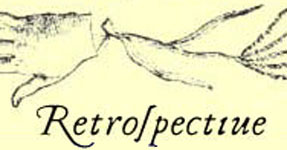

Stone Lithography
The second "advanced education activity" of my div3 career was a course at Smith College, Lithographic Techniques, ARS 271. In this class, i learned the process of stone lithography and i created 4 prints for the art section of my div3.
Stone lithography involves a _very_ heavy slab of limestone that must be sanded to a smooth, even surface- through a process called "graining"- before an image may be put on the stone. I used several techniques to draw on the stone: crayon, xerox, asphaltum, and tuche wash.
I drew on my first stone with
crayon and created the image that is now the title page of my book of writing.
For this drawing, i first drew on a piece of paper, then reversed the image
and used transfer paper to put it on the stone. Then, i used litho crayon (an
oily, black crayon) to draw and shade directly on the stone. When i was done
drawing, i wet and inked the stone and etched the stone by applying talc, rosin
then gum arabic and tannic acid etch. Once the stone is etched (as is done with
all techniques), the oily ink will be attracted only to the areas that were
drawn on with crayon.
Next, i made an asphaltum drawing on a newly grained stone. First, i spread gum arabic around the edge of the stone and let it dry to make a border. Then i rubbed asphaltum, an oil-attracting substance, to the middle of the stone. I wet and rolled the stone up with ink and let it dry. The stone was then completely inked in the center, and i cut away using "snake slip" (looks like a piece of white chalk) and a razor blade to create my image- in this case a picture of ginseng and a human body.
Then i used xerox transfer to create an image on a stone. This process was simple (and it smelled good) First, i used a xerox machine to copy and multiply a drawing i made of a human jaw and to copy some other images i found in books. Then, i applied a small amount of wintergreen oil (mmmm!) to the stone and placed the xeroxes where i wanted them. I put the stone through the press and voila! the images were transferred!
The final technique i used was tuche wash. Tuche is a liquid oily paint that can be diluted to create a range of darkness. Once it dries on the stone, it is processed as the others. I used this technique for my final litho project- chest and cabbage.
Below is a picture of the litho press!